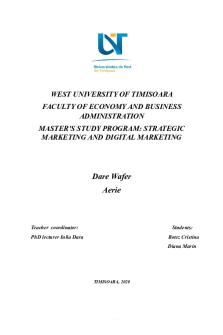Dare you see a soul at the white heat PDF

| Title | Dare you see a soul at the white heat |
|---|---|
| Course | World Literature in English |
| Institution | Langara College |
| Pages | 2 |
| File Size | 62.7 KB |
| File Type | |
| Total Downloads | 1 |
| Total Views | 167 |
Summary
Dare you see a soul at the white heat...
Description
Dare you see a soul at the white heat Intro: Dickinson’s poem “Dare you see a soul at the white heat,” describes how the soul can be burned of impurities and refined to be better in the afterlife. The soul passes through trials on earth and eventually becomes refined like an ore. She implies that, in order to ascend to heaven, one must become the best version of themselves and rid themselves of impurities and God plays the role of blacksmith to shape them. She passes on the message that death is inevitable and welcome as a step closer to reaching your core. The meter, punctuation, and structure support the idea of the soul’s final judgement day and the true nature of the soul being judged. Technique #1: Symbolism ● Ores represent human souls being shaped and forced into maturation by the forge ○ Forge represents life, God is the blacksmith Technique #2: Meter ● Increasingly regular to mirror the idea of removing the decreasing exterior of the soul to find the truth and final form at the core ● Alternating between iambic trimeter and iambic tetrameter which is common and hymnal implies that once the ore, or the soul, has been purged of sin, it will become pure and holy, judgement of whether it will be sent to heaven or hell will come afterwards Technique #3: Imagery ● Powerful imagery prevalent throughout the work following the revealing of the souls true self and the progression of judgement ○ Stanza 1 steals a glimpse of a soul being tortured, the first step to finding the truth ■ “Red” and “fire” produce hellish imagery connoting ideas of evil or unholiness, punishment in hell, “crouch” implies fear of finding out the truth of the soul ○ Stanza 2 depicts a weakened soul, where it is “quivering” and losing its strong exterior, almost as if shivering from the cold because the soul lost its clothes ○ Stanza 3 depicts God - the blacksmith - continuing to forge “even ring” implies the fair nature of the judgement system, impersonal ○ Stanza 4 illustrates the trapped light freeing the forge, presumably escaping but to a designated destination to go on to heaven or hell Technique #4: Punctuation ● Unusual of Dickinson to employ a full stop at the end of stanza two, perhaps symbolic to stop the train of thought ● Revealing the unholy core of the soul is the end point of the process and this message repeats itself
● Stanza 1 and 2 are about purification before reaching the end point and then stanzas 3 and 4 are about the blacksmith, or God, working with the soul before reaching the end point and allowing the soul to move on to either heaven or hell. ● Full stop symbolizes the break between these two accounts to indicate that they are not successive ● Dashes in stanzas 1 and 2 are used to slow down the pace of the reader and add a sense of severity to the words ● Dash used at the end of the work shows the soul moving on and indicating that it isn’t at its final destination Conclusion: Dickinson explores the idea of filling the requirement of finding the pure truth about oneself before ascending to either heaven or hell. She believes the process consists of multiple steps of peeling the layers of an individual to reach their core. The literary devices she employs offer additional depth to various aspects of the work that could not have otherwise been achieved....
Similar Free PDFs

The dare - Harley La Roux
- 98 Pages

Dare Wafer
- 5 Pages

The soul has bandaged moments
- 3 Pages

Scheda - the white queen
- 2 Pages

The White Tiger Commentary
- 2 Pages

The Dare by Harley Laroux (z-lib
- 71 Pages

Cost accounting - see the light
- 28 Pages
Popular Institutions
- Tinajero National High School - Annex
- Politeknik Caltex Riau
- Yokohama City University
- SGT University
- University of Al-Qadisiyah
- Divine Word College of Vigan
- Techniek College Rotterdam
- Universidade de Santiago
- Universiti Teknologi MARA Cawangan Johor Kampus Pasir Gudang
- Poltekkes Kemenkes Yogyakarta
- Baguio City National High School
- Colegio san marcos
- preparatoria uno
- Centro de Bachillerato Tecnológico Industrial y de Servicios No. 107
- Dalian Maritime University
- Quang Trung Secondary School
- Colegio Tecnológico en Informática
- Corporación Regional de Educación Superior
- Grupo CEDVA
- Dar Al Uloom University
- Centro de Estudios Preuniversitarios de la Universidad Nacional de Ingeniería
- 上智大学
- Aakash International School, Nuna Majara
- San Felipe Neri Catholic School
- Kang Chiao International School - New Taipei City
- Misamis Occidental National High School
- Institución Educativa Escuela Normal Juan Ladrilleros
- Kolehiyo ng Pantukan
- Batanes State College
- Instituto Continental
- Sekolah Menengah Kejuruan Kesehatan Kaltara (Tarakan)
- Colegio de La Inmaculada Concepcion - Cebu








